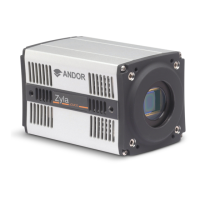version 2.0 rev 18 Feb 2021
20
2.2.3 Selecting Rolling or Global Shutter
TheselectionofRollingShutterorGlobalShuttermodesfortheZyla5.5dependsonyourspecicexperimental
conditions. A summary of the key parameters for each mode is shown in Table 3.
Table 3: A Comparison of Rolling and Global Shutter Modes
Parameter Rolling Shutter Mode Global Shutter Mode (Zyla 5.5 only)
Frame Rate Maximum available Maximum frame rate is halved
Read Noise Lowest Increased by 1.41
Spatial Distortion Dependent on object dynamics and frame rate None
Rolling Shutter Mode:withtheenhancedframeratesandlowernoise,islikelytosuitthemajorityofscientic
applications. As long as the frame rate is such that the camera is temporally oversampling object dynamics
within the image area, negligible spatial distortion will be observed. Such oversampling is good imaging
practice,sinceitisundesirabletohaveanobjecttravelasignicantdistanceduringasingleexposure.
Global Shutter Mode:forsomespecicapplicationsglobalshutterwillbeviewedasanecessity.Theseare
shown in Section 2.2.3.1.
Refer also to Andor Technical Note, “Rolling and Global Shutter”.
2.2.3.1 Examples of Typical Applications for Global Shutter Mode
• Applications that require ‘microsecond’ time gating synced to a pulsed light source: e.g. Laser
Induced Breakdown Spectroscopy (LIBS). Global readout involves a step that simultaneously transfers
the signal charge of each pixel into the corresponding readout node for that pixel. This transfer step is
2μs(at560MHzreadoutrate),facilitatingfastexposureend,i.e.‘Electronicgating’
• ‘Double Exposure’ applications: e.g. Particle Imaging Velocimetry (PIV), which requires that two back-
to-backexposuresareacquiredwithminimaltimeseparationbetweenthem.Theglobalshutter2μs
transfertimeintothereadoutnodedenestheminimumtimebetweentwoconsecutiveexposures
• Applications that require exact time correlation between two (or more) points of an image that
are separated vertically within the image: Inrollingshutterittakes10μsperrowforthe2xreadout
frontstomoveacrosstheimagefromthecentreoutwards,readingoutonerowatatime.At560MHz
pixel readout rate, this represents 10 ms to cover the distance from centre to outermost rows. That
meansanobjectatthecentreoftheimagewillbeginandendanexposure~10msbeforeanobject
located at the very top or bottom (although remember that each object will be subject to the same
overall exposure time). If a particular application requires that ‘moving or changing’ objects separated
by relatively large distances (vertically) be subject to the same beginning and end of exposure, then
global shutter mode is required
• Applications where the entire eld of view is fast moving (relative to exposure time): e.g. high speed
machine vision inspection, such as PCB inspection

